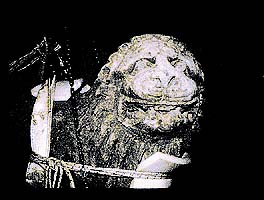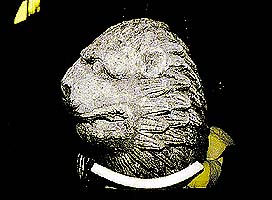The lion of Val Vidone
The recent exhibition on the material discovered in the port
of S. Rossore was marked by the return, after an absence of thirty years,
of the lion of Val Vidone, one of the most significant monuments in Etruscan
sculpture and part of the collection of the Florence Archeological
Museum from as early as the 19th century. The funeral monument was discovered
in the necropolis of Val Vidone in Tuscania in 1852 and purchased, along with
other antiquities, by the Archeological Museum of Florence in 1898. The lion,
carved out of local volcanic nenfro or tufa, is centrally placed on a circular
base which was originally about five metres in diameter. The lion gives a
menacing and aggressive impression that also seems to evoke the powers of
the underworld; it was in fact intended to frighten away intruders and very
probably set up in front of the entrance to a chamber tomb, or so it would
seem from the meagre information describing its discovery contained in the
historical archives. An inscription in square-shaped letters bearing the name
of the dead man buried in the tomb - eca suthi nevznas arnthal nès...
or, in other words, "this is the tomb of Nevzna Arnth..." - runs from right
to left across the two stone blocks that form the altar-shaped base, only
four elements of which remain, dismantled at the time of its discovery and
later recovered in the cellars of the owner of the land where it stood. The
lion of Val Vidone dates from the 4th century B.C. and, because of its size
(about 1.60 m. long and 1.10 m. high) and the quality of its formal carving,
which still shows traces of the archaic style, especially in the mane, is
a really outstanding example of the many stone lions that were created as
tomb guardians in the necropoli of southern Etruria. In iconography and style
it is very similar to the well-documented models from the eastern parts of
Greece. In
the late 19th century the lion of Val Vidone was set up in the garden of the
Archeological Museum opposite the tholos of Casale Marittimo; later, in the
1960's, it was placed in the great hall of Palazzo degli Innocenti until being
transferred to the Villa Corsini storerooms in the early 1980's, while the
Museum was being restructured. On its return from the important exhibition
on the Etruscans in the City of Mexico in 1999, the lion was placed at the
entrance to a long corridor on the ground floor which was formerly divided
up into the small dark rooms that, up until the flood of 1966, contained material
from the Central Topographic Museum of Etruria; there was a covered terrace
above where a large number of Latin epigraphs - practically a Lapidarium -
from the Museum collections were displayed. This arrangement was carried out
in the 1940's to try and make up for the Museum's chronic lack of space; the
original size of the garden was reduced and the high arches overlooking Via
Laura, where the sculpture collection had been set up in the early 20th century,
were filled in. The restoration work carried out in the 80's opened up the
arcade again but retained the covered area that had always been part of the
garden. The lion of Val Vidone has therefore been placed very close to what
was its original siting, almost as if it wishes to act as a reminder of the
Topographical Museum's past and of all the efforts that have been made to
restore the long-awaited Museum of the Etruscan Civilisation to Florence.
In
the late 19th century the lion of Val Vidone was set up in the garden of the
Archeological Museum opposite the tholos of Casale Marittimo; later, in the
1960's, it was placed in the great hall of Palazzo degli Innocenti until being
transferred to the Villa Corsini storerooms in the early 1980's, while the
Museum was being restructured. On its return from the important exhibition
on the Etruscans in the City of Mexico in 1999, the lion was placed at the
entrance to a long corridor on the ground floor which was formerly divided
up into the small dark rooms that, up until the flood of 1966, contained material
from the Central Topographic Museum of Etruria; there was a covered terrace
above where a large number of Latin epigraphs - practically a Lapidarium -
from the Museum collections were displayed. This arrangement was carried out
in the 1940's to try and make up for the Museum's chronic lack of space; the
original size of the garden was reduced and the high arches overlooking Via
Laura, where the sculpture collection had been set up in the early 20th century,
were filled in. The restoration work carried out in the 80's opened up the
arcade again but retained the covered area that had always been part of the
garden. The lion of Val Vidone has therefore been placed very close to what
was its original siting, almost as if it wishes to act as a reminder of the
Topographical Museum's past and of all the efforts that have been made to
restore the long-awaited Museum of the Etruscan Civilisation to Florence.
 It
was set up for the exhibition in its historic position, in other words, as
it was first placed in the Museum, though of course the original was somewhat
different because today the podium is incomplete. A project, as yet to be
completed, is under way to ensure the future stability of the lion as well
as to allow it to be viewed on all sides. The technicians of the Board of
Archeology, directed by Architect Pia Petrangeli, restorers Paolo Pecchioli
and Gabriele Bolognesi and coordinated by Eng. Manni and the Schaller company,
with the help of Massimiliano Montenovi, have designed a series of carbon
fibre props. The temporary scaffolding was instead carried out by the Dandoli
company. We decided to show this work " in progress" because we are convinced
that it would be wrong to hide this exceptional monument away in the Archeological
Museum's store-rooms.
It
was set up for the exhibition in its historic position, in other words, as
it was first placed in the Museum, though of course the original was somewhat
different because today the podium is incomplete. A project, as yet to be
completed, is under way to ensure the future stability of the lion as well
as to allow it to be viewed on all sides. The technicians of the Board of
Archeology, directed by Architect Pia Petrangeli, restorers Paolo Pecchioli
and Gabriele Bolognesi and coordinated by Eng. Manni and the Schaller company,
with the help of Massimiliano Montenovi, have designed a series of carbon
fibre props. The temporary scaffolding was instead carried out by the Dandoli
company. We decided to show this work " in progress" because we are convinced
that it would be wrong to hide this exceptional monument away in the Archeological
Museum's store-rooms.
Translated by Susan Glasspool
